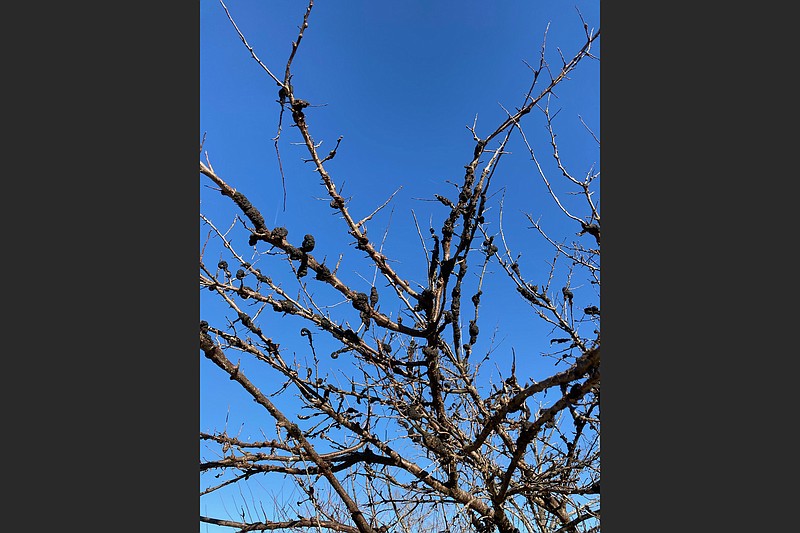Q Could this be bacterial galls I'm seeing on older Santa Rosa plum trees? If so, should I remove the older trees with galls?
A The black, gnarly growths are actually caused by a disease known as black knot of plums. Each year the disease will get worse, encircling the stems and killing the small limbs. The fungus overwinters in the knots, and new spores will emerge this spring to spread the infection. The knots can vary in size and eventually merge. At this point, prune out any branches with galls on them. There are fungicides that can help, but if the entire tree is covered, you might want to start over with a new tree.
Q With the daffodils and other flowers not standing if the snow ever melts — I use plant stakes. Home Depot and Lowe's carry them in all sizes. Price is not a problem because I have used them for years — not only on daffodils, but glads and Easter lilies and anything else that needs a little help in looking beautiful.

A The snow is melting rapidly. Staking tender plants that are lying down is a great idea. I think most of the foliage on our spring bulbs should be fine. Any stems that had open or nearly open flowers will probably need support, as they usually don't pop back up on their own. Stakes are always a good idea for heavy flower heads.
Q What type of fertilizer should I use around my bulbs?
A Use a granular, complete fertilizer (one with three numbers on it that are fairly similar, i.e., 10-10-10, 10-20-10). The numbers represent the percentage of nitrogen, phosphorous and potash. A fairly even ratio is ideal. Don't get heavy handed, a little works well.
Q I'm wanting to plant some aromatic bushes or shrubs around my house in Boone County. Will a mock orange grow here? Any other recommendations?

A You have several options. Mock orange is one; and you would do much better with lilacs in the northern tier than we can in Central or southern Arkansas. Clethra is one for summer blooms, and witch hazel would give you early scents. In a protected spot, try edgeworthia for winter blooms, itea for late spring blooms or Viburnum carlesii and Viburnum judii, which are both fragrant.

Q Thankfully, the snow is melting from my yard. I have a camellia that was covered in buds that are all brown. Do you think they will still open or should I cut the whole thing back? I guess I should never have planted this bush. What should I replace it with?
A I think you are being a bit premature. While I do think we will have some damage to plants in our gardens, it is too soon to dig up a camellia and plant something else. There are many species of camellias that add loads of color to our landscapes. Some are trickier than others, and depending on where you live, you need to choose wisely. Sasanqua camellias bloom in the fall and early winter. While we sometimes lose a few open blooms, we enjoy them for a much longer time than the later blooming camellia japonicas. They can get zapped by late freezes; but this year the early mild weather had them breaking dormancy earlier than normal. While I do think any buds showing color probably were damaged, I hope that I still have plenty of buds that were untouched and will open. Be patient and wait to see what happens.
Retired after 38 years with the University of Arkansas Cooperative Extension Service, Janet Carson ranks among Arkansas' best known horticulture experts. Her blog is at arkansasonline.com/planitjanet. Write to her at P.O. Box 2221, Little Rock, AR 72203 or email jcarson@arkansasonline.com
